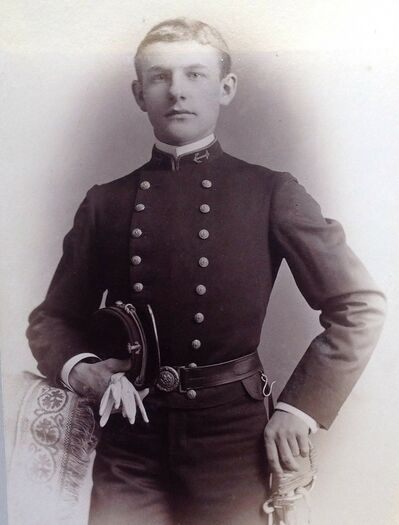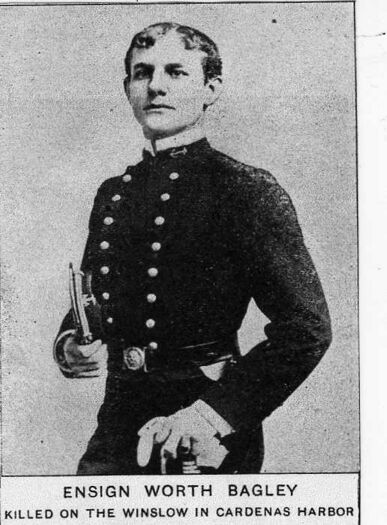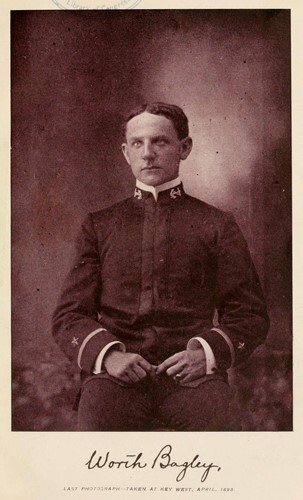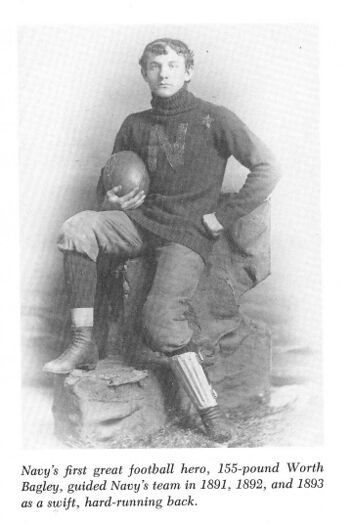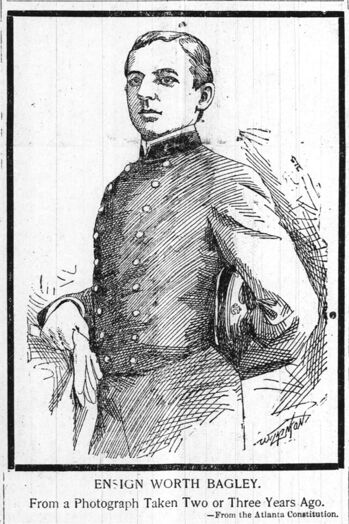WORTH BAGLEY, ENS, USN
Worth Bagley '95
Lucky Bag
From the 1895 Lucky Bag:
Bagley
Raleigh, North Carolina
C.C.P.O. Quarter-back and Full-back, Navy Football Team, 1891, 1892, 1893, 1894. Captain Class Football Team, 1892, 1893, 1894. Class Baseball Team, 1892, 1893, 1895. Chapel Choir. Holds Four N. A. A. A. Track and Field Medals. June Ball Committee. Toast at Class Supper.
Bagley
Raleigh, North Carolina
C.C.P.O. Quarter-back and Full-back, Navy Football Team, 1891, 1892, 1893, 1894. Captain Class Football Team, 1892, 1893, 1894. Class Baseball Team, 1892, 1893, 1895. Chapel Choir. Holds Four N. A. A. A. Track and Field Medals. June Ball Committee. Toast at Class Supper.
Photographs
Loss
Worth was killed in action with Spanish forces on May 11, 1898 when the torpedo boat he was aboard, Winslow (Torpedo Boat No. 5), was struck by a shell.
Other Information
From Wikipedia:
Born in Raleigh, North Carolina, a son of William Henry Bagley, he graduated at the United States Naval Academy in 1895. After serving two years on USS Montgomery, USS Texas, and USS Maine, he was made ensign, July 1, 1897. In November he was appointed inspector of the new torpedo-boat, USS Winslow and when she went into commission on December 28, he was assigned as her executive officer under Lieutenant John Baptiste Bernadou.
In April 1898, the Winslow was with the fleet, mobilized for operations in Cuban waters. On the morning of May 11 the ship went with USRC Hudson and USS Wilmington to force the entrance to the harbor of Cárdenas. She was fired upon by the Spanish gunboat Antonio López, and immediately there was a general engagement. The Winslow was soon disabled, and was with difficulty hauled out of range of the Spanish guns by Hudson. Just as the engagement ended, Ensign Bagley and four sailors were killed by a shell.
From researcher Kathy Franz:
Worth attended the Morson and Denson school in Raleigh. He won appointment to the Naval Academy in the summer of 1889 at the age of 15.
In the spring of 1891, he failed to pass his examinations at the Naval Academy, but he secured a re-appointment and graduated with the class of 1895.
Per The Farmer and Mechanic newspaper, May 17, 1898: At the Army Navy game on November, 26, 1892, he “saved the day” by an unprecedented long-distance kick. One of the admirals slapped him on the shoulder at the end of the game and said, “Bravo, boy! I made $5,000 on your kick today!”
After graduation, he went to the receiving ship Vermont, then to the Cruiser Montgomery, and then to the Texas on October 12, 1895.
On November 23, 1897, he was ordered to the Columbian Iron Works for duty in connection with the construction of the Winslow.
The newspaper above wrote the details of Worth's death: The Winslow was hit by a shot from the Spanish boats which knocked out her boiler. The Hudson tried for 20 minutes to get close enough to throw a line to the Winslow. When close enough, Worth said, “Heave her, heave her.” “Don't miss it,” shouted an officer on the Hudson. With a smile, Worth called back: “Let her come. It's getting too hot here for comfort.” The line was thrown, and at the same instant a shell burst in the very midst of the group of men on board the Winslow, and Worth was instantly killed.
The George G. Meade Post No. 1, G. A. R., of Philadelphia sent Worth's mother a snow-white wreath of immortelles supporting a rusty sword and scabbard from a Confederate officer who died at Gettysburg.
In June 1900, the Ensign Worth Bagley Camp, No. 6, Legion Spanish War Veterans, Bunker Hill District, Boston, Massachusetts, sent flowers for his grave. They also sent flowers for the launchings of the ships named in his honor.
L. B. Eaton of North Carolina gave Worth's mother a silver memorial vase for Christmas, 1901. The vase had an eagle perched on an anchor atop a disk with 45 jewel stars. The other side had an etching of Worth in full dress. The gift was in behalf of citizens from 37 states and the District of Columbia. On the base were the words: “Dulce et decrum est pro patria mori.”
Worth's monument was unveiled in Raleigh on May, 20, 1907. Captain Richmond Pearson Hobson (Class of 1889) delivered the oration. A life size oil painting of Worth had been sent for the unveiling. The North Carolinian newspaper carried a two-page spread on the unveiling.
Worth's father was a major in the Confederate Army, a member of the General Assembly, and clerk of the North Carolina Supreme Court. His mother was Adelaide, daughter of Governor Jonathan Worth. Worth's four sisters were: Mary who died young, Addie, Belle, and Ethel. Addie was the wife of the Hon. Josephus Daniels, editor of the News and Observer in Raleigh. They named their son Worth. Belle was a statistician for the Bureau of Mines, and Ethel was in the naval intelligence department. Worth's three brothers were: Edwin who died young, William, a newspaper publisher, and David ('04) who became an admiral. David's sons were David ('43), Worth ('46), and Tennent. David and Worth became admirals, and Tennent was a CIA chief who published several spy books. In 1880, their aunt Grizzelle lived with the family. She later became Mrs. Benjamin Moffitt.
He is buried in North Carolina.
Remembrances
From Heroes of the United States Naval Academy:
"Let Us Never Forget" Navy's First Army-Navy Game Running Back, USNA 1893, Killed in Action, Ensign Worth Bagley, USN
Every year many watch the Army-Navy game for its rivalry and traditions. But few realize that games in 1891 was the start of the Bill the Goat as mascot and the game in 1893 saw the first use of a padded leather helmet. Naval Cadet Bagley was the leader of that Navy team and later Ensign Bagley was the first Naval Officer killed in action during the Spanish American War.
Worth Bagley was born in Raleigh, North Carolina, on April 6, 1874 to William Henry Bagley and Adelaide (Worth) Bagley. He initial entered the Naval Academy on September 5, 1889, but resigned in June 17, 1891 due to academics. He entered the Naval Academy a second time on September 7, 1891. His younger brother also graduated from the Naval Academy, Admiral David Worth Bagley (USNA 1901). While at the Academy, Naval Cadet (rank later changed to Midshipman) Bagley became the leader of the Academy’s football team, playing in the first Army-Navy game in 1891 at West Point. It was at this game that the Navy acquired its goat mascot, a symbol which still takes the field with each Navy football team. While the Naval Cadets were on their way to the football game, they realized that other schools had a mascot and convinced a farmer to give up his goat.
This group of Naval Cadets who pioneered football at the Naval Academy in 1891 played in accordance with the rules of the day which was a combination of Soccer, Rugby and American Football. Their sport was strictly a student activity and not supported in anyway by the Naval Academy, at least along official lines. Expenses were footed by the players and a few of their student friends.
Later, Naval Cadet Bagley led the Navy team to victory over the Army team on the Navy’s home turf played on Worden Field in 1893. In a newspaper article, which added that the game was won “chiefly through the efforts of young Bagley” it was stated that: “Both teams were well coached during the season of 1893, and faced each other at Annapolis under even conditions. West Point was a trifle the stronger, but excellent generalship at critical points gave the game to Annapolis by a score of 6 to 4. Annapolis was superior in the kicking game, which was just being introduced, and this helped her defeat the soldiers.”
Unfortunately, the 1893 game resulted in post-game brawls and possible threat of a duel between an admiral and general at New York’s Army-Navy Club which caused President Cleveland to cancel future Army-Navy games. President McKinley would step in and reinstitute the game in 1899.
The 1893 game also debuted the first football helmet. The origin of the modern football helmet is credited to Naval Cadet Joseph M. Reeves, later Admiral Reeves (USNA 1894). An Annapolis shoemaker created the leather helmet for Naval Cadet Reeves, who had been advised by a Navy doctor that he would be risking death or "instant insanity" if he took another kick to the head. This helmet would also serve as the basis for the first aviator caps as Naval Aviation had its founding at Greenbury Point across the Severn River from Annapolis.
The glory of being the leader of the football team did have its cost. Naval Cadet Bagley developed a heart problem from the violent exercise and constant pounding in the days before padding and safety were a major concern to football teams. The apex of his heart was shifted two inches to the left!
Naval Cadet Bagley graduated 29 of 41 Naval Cadets on June 7, 1895.
Naval Cadet Bagley was first assigned to the battleship USS Indiana (BB-1), but was soon transferred to the armored cruiser USS Maine (ACR-1), in 1896. Fate intervened for Bagley and he was transferred off the vessel in July of 1897. Maine was destined to explode in Havana harbor in February 1898 touching off the Spanish American War.
Naval Cadet Bagley’s transfer was precipitated by his being assigned to report to the Columbia Iron Works were a torpedo boat, the Winslow, was being constructed. This time, fate would be less kind.
Having completed two years at sea as a Naval Cadet Bagley was commissioned Ensign on July 1, 1897.
In December 1897, USS Winslow (Torpedo Boat No. 5) was placed in commission, with Ensign Worth Bagley as it’s second in command under Lieutenant John Baptiste Beradou (USNA 1880).
At the beginning of hostilities between the United States and Spain late in Apri1 1898, Ensign Bagley was serving in Winslow a ship that was soon on blockade station off the northern coast of Cuba.
On May 11. 1898, Winslow left her position for Cardenas to replenish her coal bunkers from one of the larger warships located there. When she reached Cardenas, the senior officer present, the commanding officer of Wilmington ordered her to reconnoiter Cardenas Bay for mines in company with the revenue cutter Hudson. The negative report on the mines at the completion of their mission prompted Wilmington’s commanding officer to decide to take his ship into the bay to search for three Spanish gunboats reportedly lurking there. Bagley’s ship and Hudson served as escorts. At about 3,000 yards from Cardenas, a lookout caught sight of a small, gray steamer moored alongside the wharf. Winslow moved in for a closer look. At about 1335 that afternoon, Bagley’s torpedo boat reached a point about 1,500 yards from the wharf when a puff of smoke announced the beginning of an artillery duel that lasted an hour and 20 minutes. Winslow’s 1 pounder responded, and then Spanish shore batteries opened on her. The little torpedo boat bore the brunt of Spanish fury and quickly suffered a number of hits.
The first shell to strike Winslow put both her steam and manual steering out of action. While members of her crew tried to rig some type of auxiliary steering gear, Ensign Bagley carried orders to the after engine room hatch in order to keep the warship maneuvering with her propellers. However, at one point the ship swung broadside to the enemy batteries, and a shell knocked out her port main engine. Wilmington and Hudson came to the rescue with their larger guns, and Winslow requested Hudson to tow her out of action. While the two ships attempted to make fast a towline, a shell burst near the after engine room hatch. At that moment, a shell hit the armored deck, sending up a cloud of shrapnel. Ensign Bagley and four other crew fell to the deck suffering mortal wounds. Ensign Bagley’s torso was shattered and his face carried away. Lieutenant Bernadou, who had also been wounded during the action, had the bodies of the dead covered with torpedo tube covers. Soon, the Hudson was able to tow the stricken vessel to safety. The action, which was one of the few victories gained by Spanish naval forces during the war, was soon over. He was the only naval officer killed in action in the Spanish American War.
Ensign Bagley’s body and the bodies of the other dead sailors were transported to Key West. From there Ensign Bagley’s remains were taken to Jacksonville, where the corpse was presented to one of his brothers, Mr. W. H. Bagley. On May 16, 1898, the body arrived in Raleigh, North Carolina, the home of Ensign Bagley’s mother who lived at 125 South Street.
The funeral for Ensign Bagley was a huge affair. The funeral cortege included three thousand people, including fifteen hundred soldiers, twelve hundred school children, two hundred college cadets, as well as state and city officials. Since no church was large enough for the cortege and onlookers, the services were held in the Capitol Square. On the day of the funeral, the coffin was escorted into the Capitol rotunda by the Governor’s Guard, and allowed to lie in state. Schools and businesses were closed in honor of the event and flags placed at half-mast.
The young man who had escaped possible death on the Maine through fate, met his fate in the waters of Cardenas harbor. Ensign Bagley was laid to rest on Oakwood Cemetery. The young man left behind at least two sisters, two brothers and a widowed mother.
Several ironies surround Ensign Bagley. First, the man who led the Army team in the first Army-Navy game in 1891, Bagley’s opposite number, was killed in the assault on San Juan Hill. His name was Lieutenant Dennis Michie (USMA 1892). Army’s football stadium is named for Michie. Ensign Bagley’s sister married Josephus Daniels, the future secretary of the Navy. The Ensign’s brother, Lieutenant Commander David Bagley, commanded the first United States vessel sunk in World War One, destroyer USS Jacobs James (DD-61).
Memorial
Worth's grandfather was governor of North Carolina; his father had been an officer in the Confederate army. When Worth was killed, the nation -- with the help of the Raleigh News and Observer, a newspaper edited by Worth's brother-in-law -- took note of the symbolism, which was extolled as a moment to show the reunion was, if not complete, then far along the path. As such, he laid in state prior to his burial. Later, on May 20, 1907, a bronze statue of Worth was erected on the statehouse grounds in Raleigh, North Carolina.
The "Register of Commissioned and Warrant Officers of the United States Navy and Marine Corps" was published annually from 1815 through at least the 1970s; it provided rank, command or station, and occasionally billet until the beginning of World War II when command/station was no longer included. Scanned copies were reviewed and data entered from the mid-1840s through 1922, when more-frequent Navy Directories were available.
The Navy Directory was a publication that provided information on the command, billet, and rank of every active and retired naval officer. Single editions have been found online from January 1915 and March 1918, and then from three to six editions per year from 1923 through 1940; the final edition is from April 1941.
The entries in both series of documents are sometimes cryptic and confusing. They are often inconsistent, even within an edition, with the name of commands; this is especially true for aviation squadrons in the 1920s and early 1930s.
Alumni listed at the same command may or may not have had significant interactions; they could have shared a stateroom or workspace, stood many hours of watch together, or, especially at the larger commands, they might not have known each other at all. The information provides the opportunity to draw connections that are otherwise invisible, though, and gives a fuller view of the professional experiences of these alumni in Memorial Hall.
January 1896
January 1898
Namesakes
The ships Bagley (Torpedo Boat No. 24), USS Bagley (DD 185) (sponsored by his mother), and USS Bagley (DD 386) (sponsored by his sister) were named for him. USS Bagley (FF 1069) was named for Worth and his brother, Admiral David W. Bagley (sponsored by David's widow).
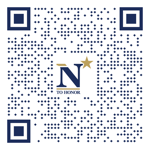
The "category" links below lead to lists of related Honorees; use them to explore further the service and sacrifice of alumni in Memorial Hall.
